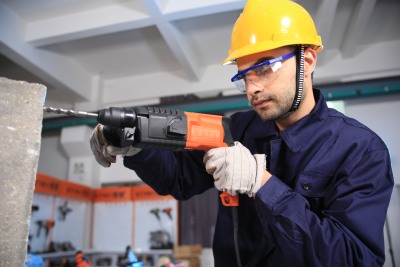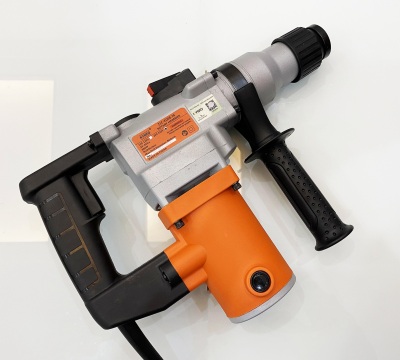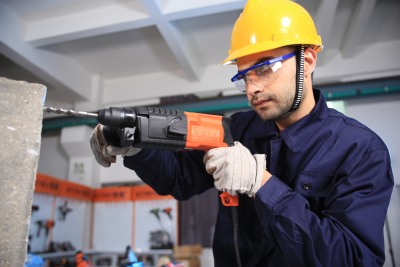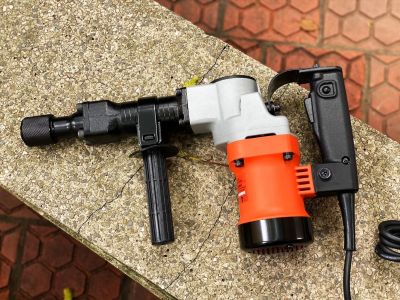
Avoid Accidents With These Rotary Hammer Safety Rules
I. Introduction
Rotary hammers are indispensable tools in construction and renovation projects, enabling workers to drill into concrete and masonry with precision and efficiency. However, the power and speed of these tools also pose significant safety risks if not handled properly. To safeguard against accidents and injuries, it is crucial to adhere to strict safety protocols when operating rotary hammers. In this guide, we will delve into essential safety rules that can help you avoid accidents and ensure a secure working environment. By understanding and implementing these safety measures, you can protect yourself and your team while maximizing the effectiveness of rotary hammer operations. Let's explore how following these safety rules can make a significant difference in your work practices and overall project outcomes.

II. Understanding Rotary Hammers
Explanation of what rotary hammers are and their common uses
Rotary hammers are robust power tools designed for heavy-duty drilling tasks in tough materials such as concrete, stone, or masonry. Unlike traditional hammer drills, rotary hammers utilize a piston mechanism, providing a powerful hammering action combined with rotational drilling. This dual-motion feature enables rotary hammers to deliver rapid and efficient drilling performance, making them ideal for tasks that demand precision and speed.
Commonly used in construction, renovation, and demolition projects, rotary hammers excel at tasks such as drilling anchor holes, setting concrete screws, and chiseling through hard surfaces. Their versatility allows workers to tackle a wide range of applications, from installing fixtures to breaking up concrete for removal. With various sizes and capabilities available, rotary hammers cater to a diverse set of drilling needs, making them indispensable tools on job sites where durability and performance are paramount.
Understanding the unique functions and applications of rotary hammers is essential for maximizing their utility while ensuring safety and efficiency in your work environment. By familiarizing yourself with the capabilities of these tools, you can leverage their power effectively while mitigating potential risks associated with their operation.
Potential hazards associated with rotary hammer operation
Operating rotary hammers, while essential for various construction tasks, entails inherent risks that can lead to accidents and injuries if safety precautions are not diligently. Understanding the potential hazards associated with rotary hammer use is crucial for maintaining a safe working environment and preventing mishaps. Here are some common risks to be mindful of:
1.Hand-Arm Vibration Syndrome
Prolonged use of rotary hammers can expose operators to hand-arm vibration, leading to conditions such as Hand-Arm Vibration Syndrome (HAVS). This syndrome can cause numbness, tingling, and reduced dexterity in the hands and arms, impacting the overall health and performance of workers.
2.Musculoskeletal Injuries
The repetitive nature of rotary hammer operation can strain muscles and joints, increasing the risk of musculoskeletal injuries like tendonitis, carpal tunnel syndrome, and back pain. Improper posture and overexertion while using the tool can exacerbate these issues.
3.Flying Debris and Dust Exposure
The high-speed drilling action of rotary hammers can generate flying debris and dust particles, posing a hazard to the operator and nearby workers. Inhaling airborne dust can lead to respiratory issues, while debris can cause eye injuries if proper eye protection is not worn.
4.Electric Shock and Power Tool Accidents
Improper handling of electrical components in rotary hammers can result in electric shock incidents. Additionally, accidents such as tool slippage, kickback, or entanglement with cords can occur if the tool is not used correctly or maintained adequately.

By recognizing these potential hazards and implementing robust safety measures, workers can mitigate risks and create a secure environment for rotary hammer operations. Prioritizing safety protocols, proper training, and the use of personal protective equipment are essential steps in safeguarding against these dangers and ensuring a safe and productive work environment.
III. Key Safety Rules
Proper Personal Protective Equipment
Ensuring the use of appropriate Personal Protective Equipment (PPE) is paramount when operating rotary hammers to safeguard against potential hazards and prevent injuries. Here are essential PPE items that should be worn during rotary hammer use:
1.Safety Glasses or Goggles
Protecting your eyes from flying debris is crucial when using rotary hammers. Safety glasses or goggles with side shields provide a barrier against particles that can cause eye injuries.
2.Ear Protection
The high noise levels generated by rotary hammers can lead to hearing damage over time. Wearing earplugs or earmuffs while operating the tool helps reduce the risk of hearing loss and ensures a safer work environment.
3.Respiratory Protection
Dust and airborne particles produced during drilling can pose respiratory hazards. Disposable respirators or dust masks should be worn to prevent inhalation of harmful substances and maintain good air quality.
4.Gloves
Using appropriate work gloves can protect your hands from cuts, abrasions, and vibrations while operating rotary hammers. Anti-vibration gloves are especially beneficial in reducing the risk of Hand-Arm Vibration Syndrome.
5.Footwear
Sturdy, slip-resistant footwear with steel toe caps provides protection against falling objects and potential foot injuries on the job site. Proper footwear ensures stability and reduces the risk of accidents.
By adhering to these PPE guidelines and incorporating them into your daily safety practices, you can significantly reduce the likelihood of accidents and injuries while using rotary hammers. Prioritizing personal safety through the consistent use of PPE is a fundamental aspect of responsible and secure tool operation.
Inspecting the Rotary Hammer
Prior to using a rotary hammer, it is essential to conduct a thorough inspection of the tool to ensure it is in proper working condition and safe to operate. Regular inspections help identify potential issues early on, mitigating the risk of accidents and promoting a secure work environment. Here are key aspects to consider when inspecting a rotary hammer:
1.Power Cord and Plug
Check the power cord for any signs of damage, such as fraying or exposed wires. Ensure the plug is intact and fits securely into the power outlet to prevent electrical hazards during operation.
2.Exterior Condition
Inspect the exterior of the rotary hammer for cracks, dents, or other visible damage that could affect its structural integrity. Any abnormalities should be addressed promptly to maintain the tool's safety and performance.
3.Chuck and Bit
Verify that the chuck is secure and functioning correctly, as a loose chuck can lead to bit slippage during drilling. Additionally, ensure the drill bit is compatible with the rotary hammer and securely fastened to prevent accidents while in use.
4.Trigger and Controls
Test the trigger and controls to ensure they are responsive and functioning as intended. Any sticking or irregularities in operation should be addressed before using the rotary hammer to prevent unexpected tool behavior.
5.Safety Features
Confirm that all safety features, such as the depth gauge, auxiliary handle, and vibration control mechanisms, are in place and operational. These features enhance user safety and help prevent accidents during drilling tasks.
By incorporating a pre-operation inspection routine into your work practices, you can proactively identify and address potential safety concerns with the rotary hammer, minimizing the risk of accidents and ensuring a safe working environment for yourself and your team.
Operating the Rotary Hammer Safely
Proper operation of a rotary hammer is crucial for maintaining a safe work environment and preventing accidents or injuries. By following these safety guidelines, you can ensure the effective and secure use of the tool:
1.Stable Positioning
Maintain a stable stance and grip on the rotary hammer while operating it. Use both hands to control the tool and keep it steady during drilling to prevent it from slipping or jerking unexpectedly.
2.Correct Bit Selection
Choose the appropriate drill bit for the material you are working with, ensuring it is compatible with the rotary hammer and securely attached. Using the right bit minimizes the risk of bit breakage or binding during drilling.
3.Controlled Drilling Speed
Avoid excessive force or pressure when drilling with the rotary hammer. Let the tool's hammering action and rotation do the work, applying gradual pressure and allowing the bit to penetrate the material at a controlled speed.
4.Depth Setting
Set the depth gauge on the rotary hammer to the desired drilling depth to prevent over-drilling or damaging underlying surfaces. Adjust the depth control according to the specifications of your drilling task for precise and safe operation.
5.Rest Periods
Take regular breaks during extended use of the rotary hammer to prevent fatigue and maintain focus. Prolonged operation without adequate rest intervals can compromise safety and lead to errors in handling the tool.
6.Emergency Procedures
Familiarize yourself with emergency shutdown procedures in case of unexpected incidents while operating the rotary hammer. Be prepared to react swiftly and safely in the event of tool malfunctions or accidents.
By adhering to these safety practices and exercising caution during rotary hammer operation, you can minimize the risk of accidents and promote a secure working environment for yourself and others on the job site.
Handling and Storing the Rotary Hammer
Proper handling and storage of a rotary hammer are essential aspects of ensuring its longevity and safe operation. By following these guidelines, you can maintain the tool's functionality and prevent accidents:
1.Carrying and Transporting
Always carry the rotary hammer with care, using both hands to support its weight and balance. Avoid swinging or mishandling the tool during transportation to prevent damage to the tool or potential injuries.
2.Storage Location
Store the rotary hammer in a secure and dry location when not in use. Keep it away from moisture, extreme temperatures, or corrosive substances that could damage the tool's components over time.
3.Cord Management
Properly coil and store the power cord of the rotary hammer to prevent tangles, kinks, or damage to the cord insulation. Avoid stepping on or running the tool over the cord during operation to maintain electrical safety.
4.Cleaning and Maintenance
Regularly clean the exterior of the rotary hammer to remove dust, debris, or buildup that can affect its performance. Follow the manufacturer's guidelines for lubrication, blade changes, and other maintenance tasks to ensure the tool functions optimally.
5.Secure Storage
When not in use, store the rotary hammer in a designated area where it is not at risk of falling or being knocked over. Use a secure storage case or rack to protect the tool from damage and prevent accidents in the workplace.
6.Tool Inspection
Before each use, inspect the rotary hammer for any signs of wear, damage, or malfunction. Address any issues promptly and do not use the tool if it is not in proper working condition to prevent accidents during operation.

By implementing these handling and storage practices, you can prolong the life of your rotary hammer, maintain its safety features, and ensure a secure working environment for yourself and others on the job site.
IV. Conclusion
In conclusion, prioritizing safety when using rotary hammers is paramount to prevent accidents and promote a secure work environment. By adhering to key safety rules such as wearing proper Personal Protective Equipment (PPE), inspecting the tool before each use, operating it safely, and handling and storing it correctly, you can mitigate risks and ensure the efficient and secure use of this powerful tool.
Remember, safety is not just a set of rules but a mindset that should be ingrained in every aspect of your work practices. Whether you are a seasoned professional or a novice operator, taking proactive measures to uphold safety standards can safeguard against potential hazards and protect yourself and your colleagues from harm.
By incorporating these rotary hammer safety rules into your daily routine and fostering a culture of safety within your team, you not only prevent accidents but also contribute to a more productive and harmonious work environment. Stay vigilant, stay informed, and always prioritize safety above all else to make every job with a rotary hammer a safe and successful one.

Categories
latest blog
Tags
© Copyright: 2003-2025 KYNKO INDUSTRIAL LIMITED All Rights Reserved.
IPv6 network supported

Talk by Wechat
